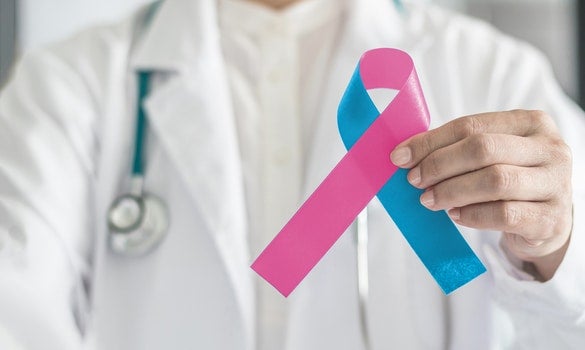
INTRODUCTION
Although rare, breast cancer can occur in males too. It accounts for approximately one percent of all breast cancer diagnoses. The relatively low amount of breast tissue is attributed to the low incidence of breast cancer in males.
Most of the published literature is on a small cohort of patients from different institutions. The treatment recommendations usually follow the guidelines of female breast cancer treatment protocols from clinical trials. Most of these trials did not include male breast cancer patients due to the smaller number of occurrences.
HOW TO DETECT MALE BREAST CANCER IN PRIMARY CARE
Similar to female patients with breast lumps, male patients also need to undergo triple assessment which includes history-taking and physical examination, appropriate radiological investigations and histology.
At the primary care level, general practitioners (GPs) can perform history-taking and a physical examination.
History-taking
In history-taking, GPs should look out for the following risk factors:
Older age
Strong family history of breast cancer
The presence of BRCA 1 and BRCA 2 mutations, usually the latter
Men who carry BRCA 2 mutations have an approximate 6.5% cumulative risk of breast cancer by age 70, while the risk for those with BRCA 1 is only 1.2%. The risk of male breast cancer in mutation carriers is substantially lower compared to females with mutations.
The recommendations from the National Comprehensive Cancer Network guidelines for men with BRCA 2 mutations are:Breast self-examination
Education about the risks and symptoms of breast cancer
Yearly clinical breast examination starting from the age of 35 years
Prostate cancer screening at the age of 45 years
Similar guidelines may be considered for BRCA 1 mutations, although the risk of breast cancer is lower. The guidelines did not recommend any screening investigations for the breast for BRCA 1 mutations.
Radiation exposure, exposure to oestrogen and oestrogen/testosterone imbalance
The presence of gynaecomastia, if associated with oestrogen excess
In the history-taking, we can enquire about the following symptoms:
- Painless and progressive enlarging breast lump, mostly in the retro areolar region (75%)
- Nipple retraction or nipple discharge
- Ulceration, bleeding or pain
- Axillary lymph nodes
Physical examination
Physical examination usually reveals a hard lump in the retroareolar region which may be fixed to skin or underlying muscle. Some patients may present with enlarged axillary nodes.
Differential diagnosis includes:
- Gynaecomastia
- Abscess
- Metastasis from other cancers
- Lipoma
- Sarcoma
TREATMENT OPTIONS BY GPs
If there is no suspicion of infection, there is no need to start any treatment. If there is evidence of infection, you can start the patient on antibiotics.
WHEN AND HOW TO REFER TO A SPECIALIST
Any breast lumps or axillary lumps in male patients need work-up by a specialist to rule out cancer.
GPs may refer patients to the SingHealth Duke-NUS Breast Centre for appointments at the following hotlines:
- Singapore General Hospital: 6326 6060
- Changi General Hospital: 6788 3003
- Sengkang General Hospital: 6930 6000
- National Cancer Centre Singapore: 6436 8288
MANAGEMENT BY SPECIALISTS
A specialist will be able to:
Arrange radiological investigations such as a mammogram or ultrasound scan
Perform a biopsy to get a histological diagnosis
Most of the symptomatic cancers are invasive ductal carcinoma histologically. Ductal carcinoma in situ constitutes only 10% of cancers. More than 90% of the invasive cancers are oestrogen- and progesterone-receptor-positive, compared to 60-70% in female cancers. They are usually negative for human epidermal growth factor receptor.
Treat diagnosed non-metastatic cancer
SurgeryThe surgical management for male breast cancer includes simple mastectomy and sentinel lymph node biopsy, and axillary clearance if sentinel nodes are positive. For the majority of patients, breast conserving surgery is not possible due to the small volume breast.
Adjuvant treatment
The adjuvant treatment recommendations are similar to female breast cancer. Since the cancer is hormone-receptor-positive, endocrine therapy is an important component.
Medications
Tamoxifen is the main drug of choice and the duration is five to ten years, depending on the risk of recurrence and side effects. Aromatase inhibitors are not as effective as Tamoxifen in males.
MANAGING MALE BREAST CANCER AT SINGHEALTH INSTITUTIONS
On the Singapore General Hospital Campus at Outram, The SingHealth Duke-NUS Breast Centre managed over 60 cases of male breast cancer from 1999 to 2019.
Most of the patients presented with symptoms, and those in the early stage underwent surgical treatment followed by adjuvant therapy according to the stage and immunohistochemistry. Those with metastatic disease went through palliative chemotherapy or endocrine therapy.
The Centre has clinical sites at Singapore General Hospital, Changi General Hospital, Sengkang General Hospital, KK Women’s and Children’s Hospital and National Cancer Centre Singapore.
Dr Preetha Madhukumar is a Senior Consultant and surgeon at the SingHealth Duke-NUS Breast Centre, under the Department of Breast Surgery.
She obtained her MBBS and Master of Surgery degree from India, and FRCS from the Royal College of Surgeons, Glasgow in 1998. She started working in Singapore in 1999 and obtained her FAMS and specialist accreditation in surgery in 2004. Since then, she has been working in the Department of General Surgery, Singapore General Hospital (SGH) before also joining the Department of Surgical Oncology, National Cancer Centre Singapore. Her main interest is in breast cancer surgery including screening and detection, surgical management and follow-up. She is also a senior consultant at the Division of General Surgery, SGH.
Apart from her clinical interests, she is very active in the educational field and in breast cancer research activities.













 Get it on Google Play
Get it on Google Play